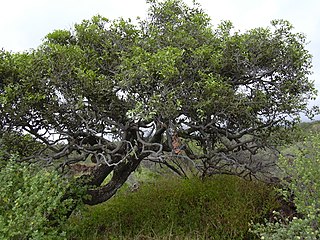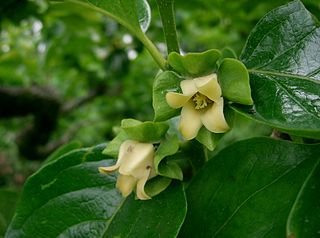
The rambutan is a medium-sized tropical tree in the family Sapindaceae. The name also refers to the edible fruit produced by this tree. The rambutan is native to Southeast Asia. It is closely related to several other edible tropical fruits including the lychee, longan, pulasan and mamoncillo.

The poinsettia is a commercially important plant species of the diverse spurge family (Euphorbiaceae). Indigenous to Mexico and Central America, the poinsettia was first described by Europeans in 1834. It is particularly well known for its red and green foliage and is widely used in Christmas floral displays. It derives its common English name from Joel Roberts Poinsett, the first United States Minister to Mexico, who is credited with introducing the plant to the US in the 1820s. Poinsettias are shrubs or small trees, with heights of 0.6–4 m (2.0–13.1 ft). Though often stated to be highly toxic, the poinsettia is not dangerous to pets or children. Exposure to the plant, even consumption, most often results in no effect, though it can cause nausea, vomiting, or diarrhea.

The persimmon is the edible fruit of a number of species of trees in the genus Diospyros. The most widely cultivated of these is the Oriental persimmon, Diospyros kaki. Diospyros is in the family Ebenaceae, and a number of non-persimmon species of the genus are grown for ebony timber. In 2019, China produced 75% of the world total of persimmons.

The Ebenaceae are a family of flowering plants belonging to order Ericales. The family includes ebony and persimmon among about 768 species of trees and shrubs. It is distributed across the tropical and warmer temperate regions of the world. It is most diverse in the rainforests of Malesia, India, tropical Africa and tropical America.

Diospyros is a genus of over 700 species of deciduous and evergreen trees and shrubs. The majority are native to the tropics, with only a few species extending into temperate regions. Individual species valued for their hard, heavy, dark timber, are commonly known as ebony trees, while others are valued for their fruit and known as persimmon trees. Some are useful as ornamentals and many are of local ecological importance. Species of this genus are generally dioecious, with separate male and female plants.

Diospyros virginiana is a persimmon species commonly called the American persimmon, common persimmon, eastern persimmon, simmon, possumwood, possum apples, or sugar plum. It ranges from southern Connecticut to Florida, and west to Texas, Louisiana, Oklahoma, Kansas, and Iowa. The tree grows wild but has been cultivated for its fruit and wood since prehistoric times by Native Americans.

Pandanus tectorius is a species of Pandanus (screwpine) that is native to Malesia, eastern Australia, and the Pacific Islands. It grows in the coastal lowlands typically near the edge of the ocean. Common names in English include thatch screwpine, Tahitian screwpine, hala tree, pandanus, and pu hala in Hawaiian. The fruit is sometimes known as hala fruit.

Diospyros mespiliformis, the jackalberry, is a large dioecious evergreen tree found mostly in the savannas of Africa. Jackals are fond of the fruit, hence the common names. It is a member of the family Ebenaceae, and is related to the true ebony and edible persimmon.

Diospyros nigra, the black sapote, is a species of persimmon. Common names include chocolate pudding fruit, black soapapple and zapote prieto. The tropical fruit tree is native to Mexico, Central America, and Colombia. The common name sapote refers to any soft, edible fruit. Black sapote is not related to white sapote nor mamey sapote.

Diospyros kaki, the Oriental persimmon, Chinese persimmon, Japanese persimmon or kaki persimmon, is the most widely cultivated species of the genus Diospyros. Although its first botanical description was not published until 1780, D. kaki is among the oldest cultivated plants, having been in use in China for more than 2000 years.

Banksia squarrosa, commonly known as pingle, is a species of prickly shrub that is endemic to Western Australia. It has linear to narrow lance-shaped leaves with up to ten sharply-pointed teeth on each side, yellow flowers in heads of about sixty and later, up to seven oblong to egg-shaped follicles in each head.

Diospyros pentamera is a common rainforest tree in the Ebony or Persimmon family (Ebenaceae) growing from near Batemans Bay in New South Wales to the Atherton Tableland in tropical Queensland, Australia. It is commonly known as the myrtle ebony, black myrtle, grey plum or grey persimmon.

Diospyros australis is the most southerly of the group of some 450 ebonies and persimmons. It is a shrub or small tree growing in rainforests of seaward eastern Australia. The habitat is in a variety of different rainforest forms, though not often seen in the cool temperate rainforests. The range of natural distribution is from Durras Lake near Batemans Bay in south east New South Wales, to Atherton in tropical Queensland.

Melaleuca squarrosa, commonly known as scented paperbark, is a plant in the myrtle family, Myrtaceae and is endemic to south eastern parts of Australia, especially Tasmania. It is an attractive shrub with dense foliage and arching branches and it flowers profusely in spring or early summer, bearing spikes of perfumed yellow to white flowers.

Diospyros mabacea, the red-fruited ebony is a rare rainforest tree in the ebony or persimmon family growing in north eastern New South Wales. Listed as endangered by extinction.

Sarcomelicope simplicifolia, commonly known as bauerella, hard aspen or yellow-wood, is a species of flowering plant in the family Rutaceae and is endemic to eastern Australia including Lord Howe and Norfolk Islands. It is a shrub or small tree with elliptic to egg-shaped leaves arranged in opposite pairs, male or female flowers arranged in small groups in leaf axils and fruit an oval to spherical drupe.

Diospyros dichrophylla (Gand.) De Winter is a Southern African tree belonging to the ebony family of Ebenaceae and closely related to the Persimmon.

Euclea crispa, commonly known as the blue guarri, is an Afrotropical plant species of the family Ebenaceae. The hardy and evergreen plants may form a dense stand of shrubs, or grow to tree size. It is widespread and common in the interior regions of southern Africa, and occurs northward to the tropics. Though some are present near the South African south and east coasts, they generally occur at middle to high altitudes. It is readily recognizable from its much-branched structure and dull bluish foliage colour. Those bearing lanceolate leaves may however resemble the Wild olive, another common species of the interior plateaus.

Trilepisium madagascariense, the urnfig or false-fig, is a species of plant in the family Moraceae, with an extensive range in the subtropical and tropical Afrotropics. It grows to a medium-sized or large tree in primary or secondary forest, or in forest patches, and is rarely cultivated.
Balanites rotundifolia, known in Swahili as Mbamba ngoma is a spiny bush or small tree from eastern Africa and southern Arabia. It is a member of the caltrop family, Zygophyllaceae.




















